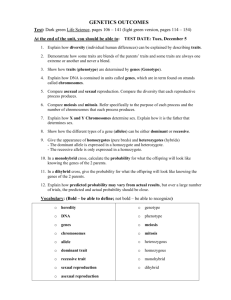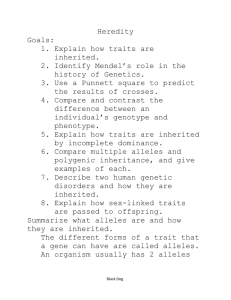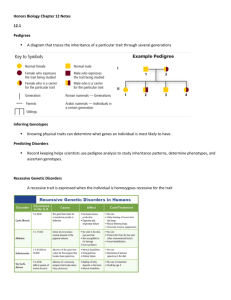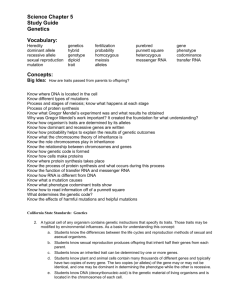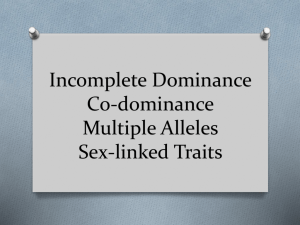Human Genetics Presentations
advertisement
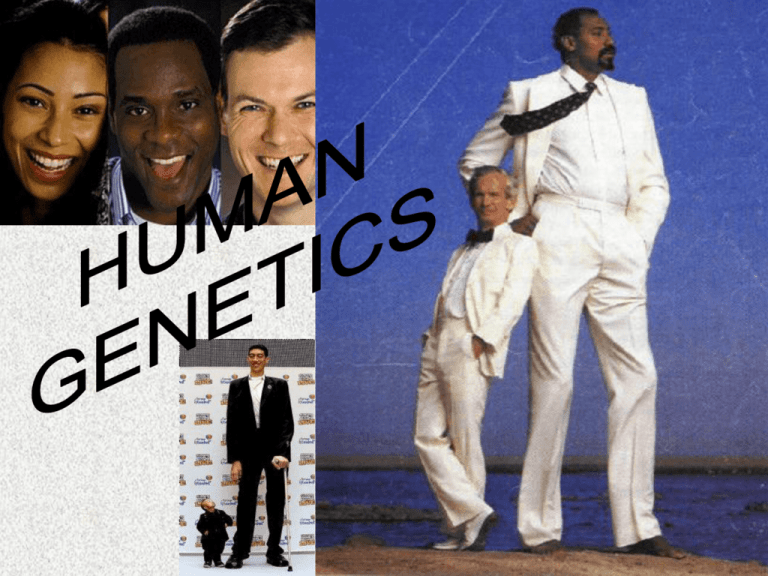
I. Introduction A. 46 chromosomes in each cell (23 pairs) B. Autosomes: all chromosomes except sex chromosomes (22 pairs) C. Sex chromosomes: determine gender (1 pair) 1.Sex determination a)XX = female b)XY = male 2.During meiosis, each egg from the female gets an X; 1/2 male sperm get X, 1/2 get Y 3.Males determine gender of offspring! a)Except in birds and reptiles where female is XY and male is XX II. Studying human genetics A. Difficult because 1. Long generations (25 yrs) 2. Single births 3. Ethical concerns B.Methods for studying humans 1.Pedigrees: record that shows how a trait is inherited within a family 2.Population sampling 1.Selecting a small # of people to represent an entire population 2.Must be a random sample 3.Ex: through random sampling, researchers discovered that 65% of people in US taste PTC, 35% cannot 3.Identical twin studies a)Identical genetic codes b)Separated at birth: study which traits are genetic(Nature) & which are environmental (Nurture) III. Inheritance of human traits A. Dominant traits 1. Polydactyly - extra fingers & toes 2. Dwarfism - small size 3. Curly hair 4. Huntington disease - nervous disorder 5. Piebaldness - white patches of hair Piebaldness=Genetic Vitiligo=AutoImmune B.Recessive traits 1.Straight hair 2.Freckles 3.Albino 4.Cystic fibrosis - lung disorder 5.Deafness 6.PKU - nervous disorder C.Codominance 1.Sickle cell anemia - irregularly shaped red blood cells • O allele = healthy(HH) • 1 allele = mild case(HS), resistant to malaria • 2 alleles = severe case(SS) D.Multiple alleles 1.3 or more alleles which code for a single trait 2.Human blood type a) 3 possible alleles: IA, IB, iO b)IA & IB are codominant, iO is recessive c)41% of US is Type O -- o allele is most common 5.Possible blood types Blood Type A B Genotypes IA IA I A iO I BI B I BiO Antigens A B AB IA IB A&B O iO iO None Universal acceptor Universal donor Example punnet squares for type A dad and type B mom E.Polygenic traits 1.Controlled by 2 or more genes 2.Skin color - the more genes, the more melanin darker skin color 3.Height - more dominant alleles taller 4. Eye Color F.Sex-linked traits 1.Genes located on X chromosome 2.Males only have one X, so only have one allele controlling these genes 3.Males more likely to have disorders that are sex-linked because they only need 1 recessive allele 4.Carrier: someone who has one allele for a disorder -does not have the disease but can pass it on to children 5.Only women can be carriers for sex-linked traits 6.Examples: hemophilia, muscular dystrophy, colorblindness 7.Color vision a)XC=Color Vision, Xc=colorblind b)Males - 8% colorblind (XcY) c)Females - 1% colorblind (XcXc) Red-Green Total Normal What are the chances for a healthy dad and a mom who is a carrier for colorblindness to have a child that is colorblind? Hemophilia in the Royal Families of Europe IV.Genetic disorders A. Nondisjunction: failure of chromosomes to separate during meiosis 1. Normal = 23 chromosomes 2. Abnormal = 22 or 24 3.Monosomy: too few chromosomes, one chromosome left unpaired a)Turner syndrome: female with only 1 X chromosome b)Short stature, sterile 4.Trisomy: too many chromosomes, extra copy of one a)Down’s syndrome: trisomy 21 b)1 in 1400 when mother under age 25, 1 in 100 by age 40 B.Detecting genetic disorders 1.Physical characteristics features, disabilities 2.Ultrasound - pictures of baby in utero using sound waves 3.Amniocentesis - sample of fluid from around baby, can examine baby’s cells http://www.biology.iupui.edu/biocourses/n100/2k4csomaldisordersnotes.html http://www.katie.com/babyblog/archives/000538.html 4.Karyotype: picture of a person’s cromosomes • taken from any cells -- blood in adults, amnio for baby Normal Trisomy 21 V. Biotechnology A. Genetic engineering: manipulating the DNA of an organism 1. Select useful traits, such as resistance to diseases 2. Transgenic organisms: contain a gene from another organism B. DNA fingerprinting 1. Analysis of DNA sequences to determine identity C.Gene therapy 1. Once we know which genes code for specific proteins and cause disorders 2. Insert a normal gene into a chromosome to replace a dysfunctional gene 3. On hold until more research can be completed


